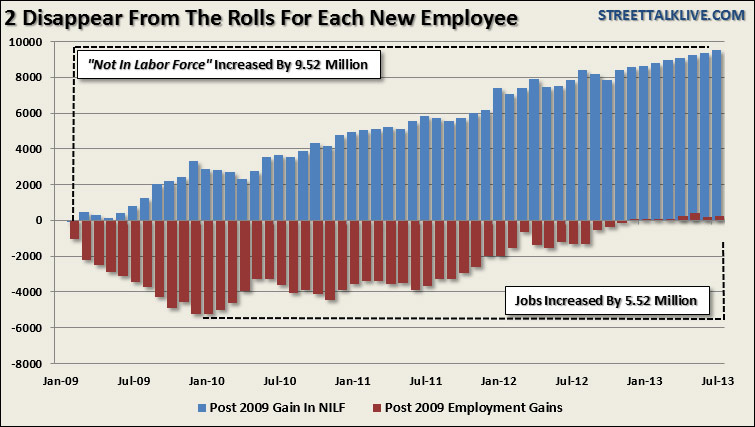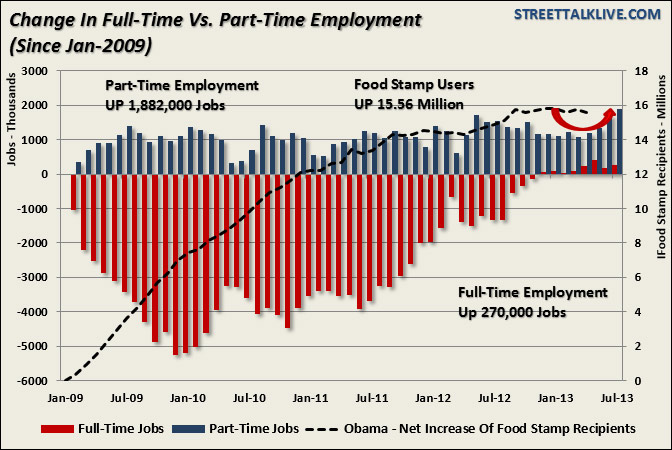The media, the financial markets and investors have become fixated on the unemployment rate, as reported by the Bureau of Labor Statistics, particularly since it was directly linked by the Federal Reserve to its current bond buying program. With the latest gyrations in the markets over the last couple of months tied to "will the Fed taper or not" the focus on employment has become much more intense since the Fed has tied its bond buying to a 6.5% full employment target.
The problem for the Fed, the markets and the economy, is that the unemployment rate, in particular the U-3 report, has become completely irrelevant.
In order for an economy to achieve a level of growth that becomes self-supporting, which means it doesn't require $85 billion a month in support to stay out of a recession, there are two primary requirements: 1) full-time employment growth that exceeds population growth, and; 2) a level of employment that absorbs the majority of currently available labor force. When these measures are met the available labor pool is reduced allowing for increases in wages and hours worked as competition for available jobs becomes increasingly more intense. In turn, increased employment leads to higher levels of consumption and stronger economic growth.
Currently, despite the Fed's ongoing monetary interventions, the economy continues to "struggle through" at an anemic pace due to the structural change that has taken place within the employment landscape. The issue for the Fed is the ongoing disconnect between the various employment reports and the real underlying issues with employment.
My friend Cullen Roche pointed out recently that:
" - We know that jobless claims have been trending lower and lower and just recorded their lowest weekly reading since the recovery started.
- The ADP private payrolls report came in at 200K – very healthy.
- The Challenger Job Cut report remains low and is showing 7.3% fewer layoffs through July 2013than the same period in 2012.
- The July ISM employment reading was 54.4 – the highest reading in well over a year.I don't know what this morning's employment report will say. It might be lower than 175K or it might be higher. But the overall data is telling a very clear story – the employment situation is improving (at worst, certainly not deteriorating)."
His comments are exactly right. However, the impact of "labor hoarding" accounts for the majority of these issues.
As I discussed previously:
"Since the end of the recession businesses have been increasing their bottom line profitability by massive cost cuts rather than increased revenue. Of course, one of the highest 'costs' to any business is labor.
The problem that businesses are currently facing is that while they have slashed labor costs to the bone there is a point to where businesses simply cannot cut further. At this point businesses have to begin to 'hoard' what labor they have, maximize that labor force's productivity (increase output with minimal increases in labor costs) and hire additional labor, primarily temporary, only when demand forces expansion.
The issue of 'labor hoarding' also explains the sharp drop in initial weekly jobless claims. In order to file for unemployment benefits an individual must have been first terminated, by layoff or discharge, from their previous employer. An individual who 'quits' a job cannot, in theory, file for unemployment insurance. However, as companies begin to layoff or discharge fewer workers the number of individuals filing for initial claims decline. This is shown in the chart below which shows the 4-month average of layoff and discharges versus the 4-week average of initial jobless claims."
[Note: We will want to pay close attention to that sharp uptick over the last couple of months in layoff's and discharges as it may be indicating weaker hiring ahead.]
"However, the mistake is assuming that just because initial claims are declining that the economy, and specifically full-time employment, is markedly improving. The next chart shows initial jobless claims versus the full-time employment to population ratio."
The issue of "labor hoarding" is an important phenomenon that is obscuring the real weakness in the underlying economy.
While the July employment report showed an increase of 162,000 new jobs at the headline; the underlying details were very disappointing. First, both of the previous months were revised substantially lower and it is likely that the months preceding those were also weaker but will not be adjusted until 2014. Secondly, the labor force participation rate fell as the number of individuals falling out of the labor force jumped 239,000 which substantially usurped those gaining employment. Lastly, as has been the trend, the majority of the jobs created were temporary versus full-time employment.
It is three points that should be of the most concern to the Federal Reserve.
Win The Battle - Lose The War
In the latest employment report while there was a net increase of 162,000 the civilian working-age population expanded by 204,000 individuals. The chart below shows employment versus population growth on a monthly basis.
The next chart shows the number of jobs created versus the number of individuals that have left the labor force since 2009.
From the lows of the recession there have been roughly 5.52 million jobs created. However, there are only 270,000 more jobs today than there were in January of 2009. However, during that same time frame 9.52 million individuals have simply fallen out of the labor force. The argument has generally been that these individuals have slipped off into retirement. If these was truly the case we wouldn't be near record levels of food stamp participation.
The importance of these two specific points is that while the Federal Reserve has a target of 6.5% unemployment that target could be achieved, not by increases in actual employment, but through further deterioration of the labor force and increases in population. While the Fed could certainly claim victory in achieving their "full employment" target; the economic war will be have been soundly lost.
Are We Already At Full Employment?
There cannot, and will not, be a lasting economic recovery without the resumption of "full-time" employment that outpaces the rate of population growth. The mirage of falling layoffs and jobless claims, while providing optimistic headlines, is not evidence of improving employment but rather "full employment levels" for the current economic environment. With the Affordable Care Act on the horizon that is set to massively increase employment costs on businesses there is little incentive to hire outside of actual demand with a focus on temporary versus full-time hires. The chart below shows the recently increasing rate of temporary employment versus full-time staffing.
The good news is that "labor hoarding" does eventually lead to sharp increases in wages and hours worked when real economic growth returns as a tight labor market is very inelastic. The problem for the Fed is that the large and available labor pool, high levels of productivity and drive to maintain profitability is keeping companies on the defensive which keeps wages suppressed and employment constrained. Lower wage paying jobs, combined with higher costs of living, leads to lower rates of consumption. As shown in my recent report on PCE the demand side of the equation is not currently sufficient to push businesses to expand particularly in the face of rising health care and benefit costs.
The problem for the Fed is that the current unemployment rate of 7.4% is a fallacy that doesn't truly express the true state of unemployment in the economy today. If we include those individuals that are working part-time, because they can't get a full-time job, and those on unemployment for longer than 52 weeks the unemployment rates skyrockets to over 15%. The chart below shows the long term chart of employment and the percentage deviation from the long term trend.
What is clearly evident is that, despite the headline reports, there is clearly an alarming divergence in employment from the long-term trend. The structural shift in employment away from manufacturing and production to a service and outsourced based economy has clearly created a deviation that will not likely be corrected for decades to come. The implications for the Federal Reserve, and the economy, should be concerning. While the hope is that the economy will suddenly spark back towards stronger growth; the supply/demand imbalance suggests otherwise. Bond buying programs that artificially fuel asset prices does not create economic stability for the millions of individuals that are out of work, living on food stamps, and working part-time jobs just to make ends meet.
As I stated above it is very likely that the Fed will get to its target of 6.5% unemployment. It just doesn't mean that 94.5% of the labor force will actually be working.
Source: Street Talk Live











